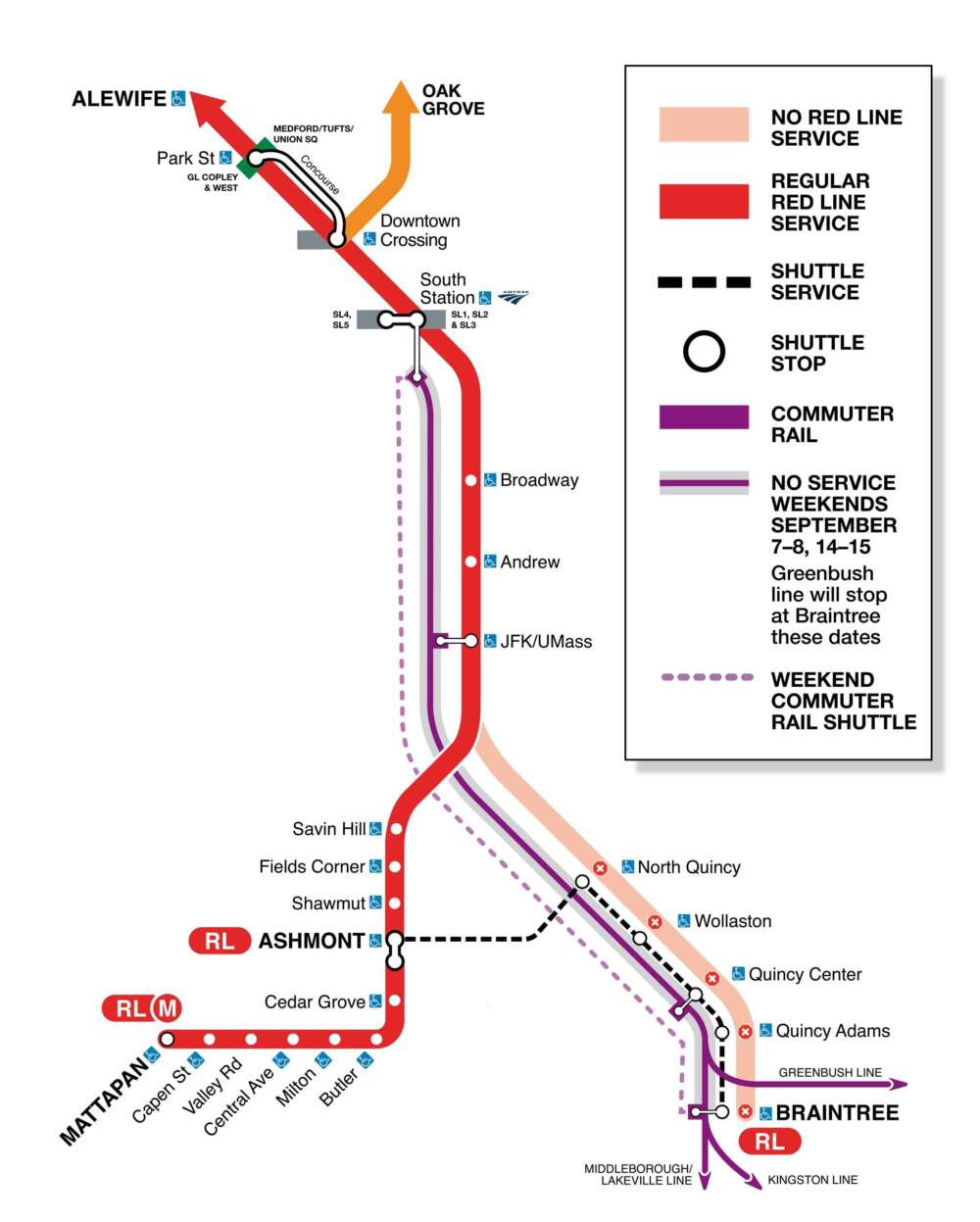Advertisement
Boston's Morning Newsletter
The T's longest closure of the year has begun. Here's how to get around it

Editor's Note: This is an excerpt from WBUR's daily morning newsletter, WBUR Today. If you like what you read and want it in your inbox, sign up here.
TGIF! The New England Patriots kick off a new era this weekend, with a new coach, new culture, new-ish quarterbacks — even new kickoffs. ESPN’s Mike Reiss spoke with Morning Edition here about what to expect this season (and how to perhaps find joy in low expectations).
But first, the news:
Wake me up when September ends: The MBTA’s 24-day closure of the Red Line’s Braintree branch begins today. Subway service is suspended between JFK/UMass and Braintree until the final day of the month, Monday, Sept. 30. The T is promising faster service — and eventually extra-fast trains — when they finish repair work along the 18-mile stretch of tracks. Still, the diversion means a big wrench in the commutes for more than 20,000 weekday riders over the next three weeks and change. Here’s a look at your alternative options:
- Commuter rail: The MBTA is making the three commuter rail lines that run parallel to this part of the Red Line — the Kingston, Middleborough, and Greenbush lines — free to ride between Braintree and South Station during the closure. All three lines also make stops along the way at Quincy Center and JFK/UMass. According to the T, there should be a train every 20 to 30 minutes. They’re also faster than normal Red Line service, getting you from Braintree to South Station in less than 3o minutes. T officials are “strongly” encouraging this option. (They’re also adding extra commuter rail coach cars to accommodate Red Line riders.)
- One caveat: As part of the repair project, these commuter rail lines will also be shut down over the next two weekends — Sept. 7-8 and Sept. 14-15 — and replaced by a free shuttle bus that runs directly between Braintree and South Station.
- Shuttle bus: Free shuttle buses will also be making stops at every closed Red Line station (Braintree, Quincy Adams, Quincy Center, Wollaston, North Quincy). But it’s worth noting, they will run to Ashmont station (rather than JFK/UMass) and will be a lot slower than the commuter rail. “A rider traveling to Park Street from Braintree should anticipate an extra 40 minutes in addition to their regular commute,” the T said in a press release this week.
- Drive: If you have a car, it’s always an option. Just know that the I-93 drive between Braintree and downtown Boston can easily take over an hour during rush hour, according to Google Maps.
Advertisement

On campus: Emerson College is ringing in fall semester with new rules restricting where students can protest. The policy specifically bans protests across much of college’s property — from classrooms to offices, residence halls to the library — as well as the alley where students stood up a pro-Palestinian encampment this past spring. It comes after Emerson’s president partly blamed last semester’s protests for contributing to a drop in enrollment at the school.
- Is there anywhere students can protest? Yes. Emerson officials have dedicated seven indoor spaces where demonstrations may be held — as long as students pre-register them at least a week ahead, hold events between 8 a.m. and 7 p.m., and do not include any tents or other physical structures. (Want to protest outside? The college suggests going across the street to Boston Common.)
- Go deeper: WBUR’s Katie Cole has more here on the new policy and how it compares to protest rules at other local colleges.
In the wind: Massachusetts, Connecticut and Rhode Island are expected to announce the winners of their joint offshore wind bidding process today. The states are looking to sign contracts for up to 6,800 megawatts of wind power — enough to power 3.7 million homes.
- Catch up: The states joined forces in response to some recent challenges the offshore wind industry has faced, like rising costs. The developers behind several projects that canceled their contracts last year are hoping to be re-selected at a higher price.
How much? Massachusetts officials confirmed that they expect to provide more than $489 million over three years to help keep afloat the local hospitals owned by Steward Health Care (or at least the ones that are still open) as they transition from the bankrupt company to new owners. So far, the state has already spent $72 million.
- Meanwhile: Sens. Elizabeth Warren and Ed Markey are pushing to hold Steward CEO Ralph de la Torre in contempt of Congress after he refused to testify at a Senate hearing scheduled next week.
P.S.— Do you know why Massachusetts Democrats relocated their Labor Day breakfast this week? Take our Boston News Quiz and test your knowledge of this week’s stories.
